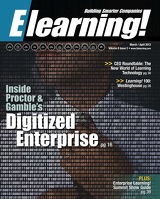Elearning! Magazine: Building Smarter Companies via Learning & Workplace Technologies.
Page 28 of 52
advancede-learning
E-LEARNING AT WESTINGHOUSE Westinghouse views online blended learn- ing as an equal player in its training deliv- ery portfolio, capable of providing training that is at least equivalent to traditional face-to-face training and in some cases superior. The global nature of its opera- tions provides unique training challenges: e-learning provides a business solution for situations in which face-to-face training is not possible because of diverse locations, time zone differences, shift work and plant operations schedules. The governing training philosophy
emphasizes building relationships with cus- tomers in order to truly understand their training needs. These relationships then allow Westinghouse trainers to determine if a training solution is appropriate and whether that solution should be e-learning or face-to-face delivery. The training provid- ed by Westinghouse's Corporate University is nuclear-centric, with the focus of the train- ing is on how that system functions in the context of an integrated nuclear power plant. Similarly, Westinghouse does not simply
conduct leadership training. It develops leaders who are prepared to work effec- tively in the nuclear industry. The company calls this focus
"Nuclearning." The corporate university, which serves both internal and external audiences, plays a central role in enforcing this philosophy and ensuring that it is con- sistently applied. To a large extent, the Nuclearning philosophy differentiates Westinghouse training from its competition. Training can be synchronous (instructor-
led classroom, lecture-based Webcasts, virtu- al classroom activities, video conferencing, laptop simulators), asynchronous (self-paced Web-based, instructor-facilitates online, multimedia-enhanced job aids, podcasts, videos, knowledge management portal, com- puter models), or some combination of both. The idea is to move training beyond the classroom and make it a part of the day-to- day life of the student. Communities of learning begin to form during formal class- room or online programs and then continue to grow in the workplace. "Learning is a process, not just an event," say the learning leaders at Westinghouse. The university facilitates company-wide
e-learning. It identifies knowledge gaps and then develops e-learning programs to
28 March / April 2012 Elearning!
close them. When a training program already exists, the university's trainers look for ways to improve these programs and adapt them for online delivery if appropri- ate. The goal is to create a fluid workforce by creating programs that can be applied company-wide. The college structure of the university, with product line managers serving as deans, ensures that the "voice of the business" is always part of the training and learning process. This helps ensure that training remains focused on perform- ance and that it is relevant to the business.
The college struc- ture of the univer- sity, with product line managers
serving as deans, ensures that the
'voice of the busi- ness' is always
part of the train- ing and learning process.
New technology — specifically mobile
devices — are just beginning to enter the training process. Most employees are pro- vided with laptop computers. Instructors and students sometimes receive iPads or other tablet devices. "Our first class produced a ton of print-
ing costs, and we found that if we just loaded iPads with all our training material, and provided each student with them while they were in training, we saved a lot," says Rick Paese, e-learning project manager for Startup and Operations Support. Adds John Bartocci, operations training
instructor for the AP1000 training group: "In New Plant Training, instead of just plain laptops, we actually equipped all our trainers with tablet PCs." Existing training programs have not yet been modified to take advantage of mobile e-
learning, but training-on-demand and virtual training are top priorities for the coming year. "We are beginning to look at how we
can use mobile and social learning within our industry," notes Aigner. "With the security concerns in the nuclear industry, we work with our current infrastructure and Information Technology security teams to implement our technical solu- tions. In the next couple of years, we expect these trends to be a major area of growth. Westinghouse's Corporate University will drive this change."
EVALUATION AND ASSESSMENT The nuclear industry is committed to the Systematic Approach to Training (SAT) methodology. Nuclear customer, regulato- ry and oversight organizations have made SAT an integral part of all industry train- ing activities. "For our training programs, the evalua-
tion part of the SAT process is probably the most important, and it really doesn't end," notes Paese. "We send out engineers into the field. We constantly ask them for feed- back, any operating experiences, or any les- sons learned to continually find new ways to train them before we send them out to the next job. We have a lessons-learned database and active communication with trainees, so we do have a system in place." Aigner says that the feedback process is
very elaborate: "We take feedback from stu- dents, instructors and customer report cards. We make any improvements that are neces- sary, but we also continually follow up with the customer after the training event to get anecdotal evidence on improvement in per- formance or any gaps we need to address. "As far as quantitative metrics," she con-
tinues, "we're also beginning to implement pre- and post-testing several months after a training event has ended. Then we want to measure knowledge retention by giving another exam six months after the training has been completed. One of the interesting observations so far is that retraining-level students have to get on a regular schedule, because many of them have not had train- ing for many years, and pre-tests show that their knowledge base has degraded signifi- cantly. But once the training is implement- ed, we then see a big spike in test results." Adds Corrigan: "One aspect that the university is focusing on for the upcoming
